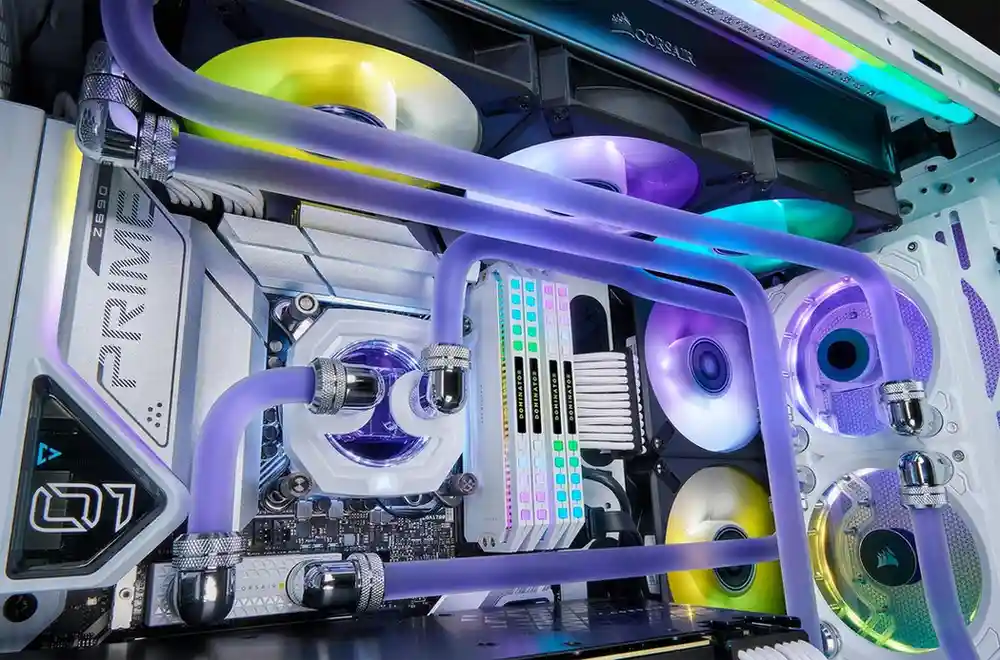Are you tired of your PC sounding like a jet engine during intense gaming sessions? Or maybe you’re pushing your hardware to its limits and need better cooling? If so, it’s time to dive into the world of PC water cooling! This guide will walk you through everything you need to know, from the basics to building your own custom liquid masterpiece. Get ready to transform your noisy, hot rig into a silent, icy-cold powerhouse.
Table of Contents
Key Takeaways
- Superior Cooling & Silence: Water cooling often cools better and is much quieter than traditional air cooling, especially for high-performance PCs.
- Two Main Options: You can choose between easier-to-install All-in-One (AIO) coolers or more complex, high-performing custom loops.
- Customization Heaven: Custom water cooling lets you pick every part, from tubing color to block design, making your PC truly unique.
- Requires Care: While powerful, water cooling needs careful installation and regular maintenance to prevent leaks and keep things running smoothly.
- Not Just for Pros: With a little research and patience, even a beginner can get started with water cooling and enjoy its benefits.
What is PC Water Cooling, Anyway?
So, what exactly is PC water cooling? Imagine your computer’s brain (the CPU) and graphics powerhouse (the GPU) working super hard. They get really hot, just like a car engine. Traditional air coolers use metal fins and fans to blow that heat away. Water cooling, on the other hand, uses a liquid (usually a special coolant) to move the heat away from these hot parts to a radiator, where fans then cool the liquid. It’s like your car’s cooling system, but for your PC!
Think of it this way: water is much better at absorbing and carrying heat than air. This means water cooling can move heat away from your components more efficiently, keeping them cooler. Cooler parts often mean better performance and a longer lifespan for your expensive gear.
Why Choose Water Cooling?
You might be thinking, “My air cooler works fine, why bother?” Well, here are a few compelling reasons why PC enthusiasts often choose to take the plunge into water cooling:
- Lower Temperatures: This is the big one! Water cooling can significantly drop your CPU and GPU temperatures, especially under heavy load. Lower temps mean your components can run faster (overclocking) without overheating, giving you more frames per second in games or quicker rendering times.
- Quieter Operation: Air coolers, especially powerful ones, can get loud. Really loud. All those fans spinning at high speeds create a lot of noise. Water cooling systems often use fewer, larger fans on radiators that can spin slower, leading to a much quieter PC. Imagine gaming or working in near silence – it’s a game-changer!
- Stunning Aesthetics: Let’s be honest, a custom water-cooled PC looks incredible. The clear tubing, colorful coolants, and sleek water blocks can turn your computer into a work of art. It’s a fantastic way to show off your build and express your personal style.
- Better Overclocking Potential: Because water cooling keeps temperatures lower, it gives you more headroom to push your CPU and GPU beyond their factory speeds. This can unlock extra performance you wouldn’t get with air cooling.
- Space Efficiency (Sometimes): While custom loops can take up space, some AIO coolers can be more compact than bulky air coolers, freeing up room around your CPU socket.
“For serious PC builders and gamers, water cooling isn’t just about performance; it’s about crafting a masterpiece.”
Types of Water Cooling Systems
When it comes to water cooling, you generally have two main paths:
1. All-in-One (AIO) Coolers
AIOs are the easiest way to get into water cooling. They come as a sealed unit, meaning you don’t have to worry about filling, bleeding, or maintaining the liquid yourself. It’s all pre-assembled and ready to go.
Pros:
- Easy Installation: Just like installing an air cooler, but with a radiator.
- Less Maintenance: No need to change coolant or worry about leaks (they are factory sealed).
- Cost-Effective: Generally cheaper than a full custom loop.
- Good Performance: Better than most air coolers, especially for CPUs.
Cons:
- Limited Customization: You can’t change components or add your GPU to the loop.
- Performance Ceiling: While good, they won’t match the cooling power of a well-designed custom loop.
- Fixed Components: If one part fails, you usually replace the whole unit.
AIOs are a great starting point for anyone curious about water cooling without the commitment of a custom build. They’re popular for cooling just the CPU.
2. Custom Water Cooling Loops
This is where the magic (and complexity) happens! A custom loop is built from individual parts – a CPU block, GPU block, pump, reservoir, radiator, tubing, and fittings – all chosen by you. This allows for maximum performance, customization, and the ability to cool multiple components.
Pros:
- Unmatched Performance: The best cooling you can get for your PC components.
- Ultimate Customization: Choose colors, materials, and designs for every single part. Your PC will truly be one-of-a-kind.
- Cool Multiple Components: You can cool your CPU, GPU, and even motherboard components in a single loop.
- Longevity & Upgradability: If one part fails, you can replace just that part. You can also easily upgrade or expand your loop later.
Cons:
- Complex Installation: Requires careful planning, assembly, and leak testing. Not for the impatient!
- Higher Cost: Buying individual, high-quality components adds up quickly.
- Regular Maintenance: Requires periodic coolant changes and system checks.
- Risk of Leaks: While rare with proper installation, there’s always a small risk of a leak, which can damage components. This is why it’s crucial to be careful. Speaking of risks, did you know some Beats Studio Pro aren’t waterproof? It highlights how important it is to keep water away from sensitive electronics, especially inside your PC! Similarly, you might wonder are AirPods waterproof? The answer is usually no, they’re just water-resistant, which is a big difference when dealing with electronics and liquids!
For the true enthusiast seeking peak performance and a unique build, a custom loop is the way to go.
Key Components of a Custom Water Cooling Loop
Building a custom loop is like putting together a puzzle, where each piece plays a vital role. Here’s a breakdown of the main components:
- 1. Water Blocks: These are the parts that sit directly on your CPU and/or GPU. They have tiny channels inside that coolant flows through, absorbing heat directly from the component.
- CPU Block: Essential for any water-cooled PC.
- GPU Block: Optional, but highly recommended for gaming PCs as GPUs generate a lot of heat.
- 2. Radiator: This is where the heat leaves your system. It looks like a car radiator, with fins and tubes. Fans are attached to push air through the fins, cooling the liquid inside. Radiators come in various sizes (e.g., 120mm, 240mm, 360mm, 480mm), indicating how many 120mm fans they can hold.
- 3. Pump: The heart of your loop! The pump circulates the coolant through all the components. Without it, the coolant would just sit there and get hot.
- 4. Reservoir: This is a container that holds extra coolant and helps with filling and removing air bubbles from the loop. It usually sits before the pump.
- 5. Tubing: This connects all your components. You have two main choices:
- Soft Tubing: Easier to work with, more flexible, great for beginners.
- Hard Tubing: Offers a cleaner, more rigid, and aesthetically pleasing look but is much harder to bend and install, often requiring special tools.
- 6. Fittings: These are the connectors that secure the tubing to your water blocks, radiator, pump, and reservoir. They come in various types (compression, push-to-lock) and sizes to match your tubing.
- 7. Coolant: Not just plain water! Special coolants prevent corrosion, algae growth, and often come in vibrant colors to make your build pop.
Planning Your Water Cooling Loop: Measure Twice, Cut Once!
Before you start buying parts, you need a plan. This is probably the most critical step.
- Compatibility:
- CPU Socket: Ensure your CPU block matches your CPU’s socket type (e.g., Intel LGA1700, AMD AM5).
- GPU Model: If cooling your GPU, the water block must be specifically designed for your exact GPU model (e.g., NVIDIA RTX 4090 Founders Edition).
- Case Support: Check your PC case’s specifications for radiator support. Can it fit a 360mm radiator? Does it have enough space for a pump/reservoir combo?
- Radiator Size: Bigger radiators mean better cooling. Aim for at least a 240mm or 360mm radiator for a CPU-only loop, and more if you’re adding a GPU.
- Tubing Type: Soft tubing is forgiving for beginners. Hard tubing requires more skill and tools (heat gun, bending mandrels).
- Budget: Custom loops can be expensive. Set a realistic budget and stick to it.
- Research: Watch YouTube videos, read forums, and look at other people’s builds for inspiration and tips. Sites like EKWB or Corsair Hydro X offer configurators to help you pick compatible parts.
Installation Guide (The Simplified Version)
Building a custom loop is a detailed process, but here’s a simplified overview of the steps:
- Preparation:
- Gather all your tools: screwdrivers, thermal paste, cutting tools for tubing, leak tester, microfiber cloth, distilled water.
- Read the manuals for each component. Seriously, don’t skip this!
- Clean your workspace.
- Mount Water Blocks:
- Carefully remove your CPU cooler and GPU cooler (if applicable).
- Clean off old thermal paste.
- Apply new thermal paste and mount your CPU and GPU water blocks according to their instructions. This is a delicate step, so take your time.
- Install Radiator & Fans:
- Mount your radiator(s) to your PC case.
- Attach the fans to the radiator, making sure they are oriented to push or pull air in the desired direction (usually pushing air out of the case for exhaust, or pulling air in for intake).
- Install Pump & Reservoir:
- Mount your pump and reservoir combo (or separate units) in your chosen location within the case. Make sure they are secure.
- Plan Your Loop Route:
- Before cutting, visualize how your tubing will connect all the components. Aim for the shortest, cleanest runs possible while avoiding kinks.
- Cut & Install Tubing:
- Measure carefully! It’s better to cut a little long and trim than too short.
- For soft tubing, simply push it onto the fittings and secure with compression rings.
- For hard tubing, you’ll need a heat gun to bend it. This takes practice!
- Fill the Loop:
- Connect a fill port (usually on the reservoir) to a bottle of coolant.
- Slowly fill the reservoir.
- Crucially, only power the pump (you can use a jumper on your PSU to power it without turning on the whole PC). This allows you to fill the loop and get rid of air bubbles without risking your other components.
- Tilt your PC gently to help trapped air escape.
- Keep filling until the loop is full and no more large bubbles appear.
- Leak Testing:
- This is the most important step! After filling, let your pump run for at least 6-24 hours with only the pump powered.
- Place paper towels under all fittings and components.
- Watch for any drips or wet spots. If you see one, tighten the fitting or re-do the tubing run.
- For an extra layer of safety, consider buying an air pressure leak tester. It’s much safer than liquid testing.
- Power On & Enjoy!
- Once you’re absolutely sure there are no leaks, connect all power cables to your components, power on your PC, and enjoy your silent, cool rig!
Maintenance Tips for a Happy Loop
A custom water cooling loop isn’t a “set it and forget it” system. Regular maintenance is key to its longevity and performance.
- Check Coolant Levels: Periodically check your reservoir to ensure the coolant level hasn’t dropped. Top it off if needed.
- Inspect for Leaks: While rare after the initial leak test, it’s good practice to occasionally check for any signs of leaks, especially around fittings.
- Coolant Replacement: Most manufacturers recommend replacing your coolant every 6-12 months. Over time, coolants can degrade, and clear coolants can become cloudy.
- Clean Radiator & Fans: Dust buildup can reduce cooling efficiency. Use compressed air to clean your radiator fins and fan blades.
- Clean Water Blocks (Every 1-2 Years): Over a longer period, sediment or gunk can build up in your water blocks, especially in the micro-fins. You might need to disassemble them and clean with a soft brush and distilled water.
Water Cooling vs. Air Cooling: The Showdown!
Let’s break down the main differences to help you decide.
| Feature | Air Cooling | Water Cooling (AIO) | Water Cooling (Custom Loop) |
|---|---|---|---|
| Performance | Good to Very Good | Very Good to Excellent | Excellent to Superior |
| Noise Level | Can be loud under load | Quieter than air, but pump noise can exist | Very quiet, especially with large radiators |
| Cost | Low to Moderate | Moderate to High | High to Very High |
| Complexity | Easy installation | Easy installation | Very complex, requires planning & skill |
| Maintenance | Low (dust cleaning) | Low (dust cleaning) | Moderate to High (coolant changes, leak checks) |
| Aesthetics | Can be bulky, less visually appealing | Sleek, but limited customization | Highly customizable, stunning visuals |
| Risk | Very Low (mechanical failure) | Very Low (pump failure, rare factory leak) | Low (but potential for leaks if improperly installed) |
| Target User | Casual users, budget builders, general use | Gamers, moderate overclockers, clean builds | Enthusiasts, extreme overclockers, aesthetic lovers |
Common Myths and Misconceptions
- “Water cooling is super dangerous, it will leak and destroy my PC!” While a leak is a risk, modern components and proper installation make it very rare. Most leaks are tiny drips during initial testing, not catastrophic floods.
- “It’s only for extreme overclockers.” Not true! Many people use water cooling simply for the reduced noise and amazing looks, even without overclocking.
- “You have to use colored coolant.” Nope! Clear coolant is very popular, especially if you want to see your components clearly or use RGB lighting for color.
- “It’s maintenance-free.” Definitely not! As discussed, regular checks and coolant changes are necessary.
- “It’s too hard for a beginner.” While custom loops are challenging, they are achievable with patience and research. AIOs are beginner-friendly.
Troubleshooting Common Issues
- High Temperatures:
- Check fan orientation: Are fans pushing air through the radiator correctly?
- Dust buildup: Clean radiator fins.
- Air bubbles: Tilt the case to help air escape, run pump at max speed for a bit.
- Coolant flow: Is the pump working? Is anything blocking the flow?
- Pump Noise:
- Air in loop: This is common during initial setup. Let the pump run, tilt the case.
- Pump speed: Try lowering the pump speed if it’s too loud (though don’t go too low if temps are high).
- Leaks:
- Immediately shut down PC! Disconnect power.
- Identify the source of the leak.
- Tighten fittings, re-seat tubing, or replace faulty components.
- Clean up any spilled coolant with distilled water and let everything dry completely before powering on again.
Anyway, while dealing with PC issues, it reminds me of how sometimes simple tech issues can be frustrating, like figuring out how to turn off Beats Studio Pro or wondering do Beats Solo 4 have noise cancelling. It’s all about knowing your tech! And sometimes, even connecting something as simple as AirPods to a laptop can throw people for a loop.
Your Water Cooling Component Selector
Planning your custom water cooling loop can be tricky. This tool helps you select components based on your CPU and GPU, suggesting compatible parts to get you started!
Custom Water Cooling Loop Planner
Step 1: Select Your Core Components
Step 2: Choose Your Preference
*This tool provides general recommendations. Always double-check specific component compatibility with manufacturers before purchase.
Final Thoughts: Is Water Cooling for You?
So, you’ve learned a lot about PC water cooling. Is it for everyone? Probably not. If you just want a simple, reliable PC for everyday tasks, a good air cooler or AIO will serve you well. But if you’re an enthusiast, a hardcore gamer, or someone who loves to tinker and make their PC truly stand out, then diving into custom water cooling can be an incredibly rewarding experience.
It requires patience, attention to detail, and a willingness to learn, but the result is a PC that runs cooler, quieter, and looks absolutely stunning. It’s more than just a performance upgrade; it’s a statement. Go on, take the plunge – your PC (and your ears!) will thank you.



